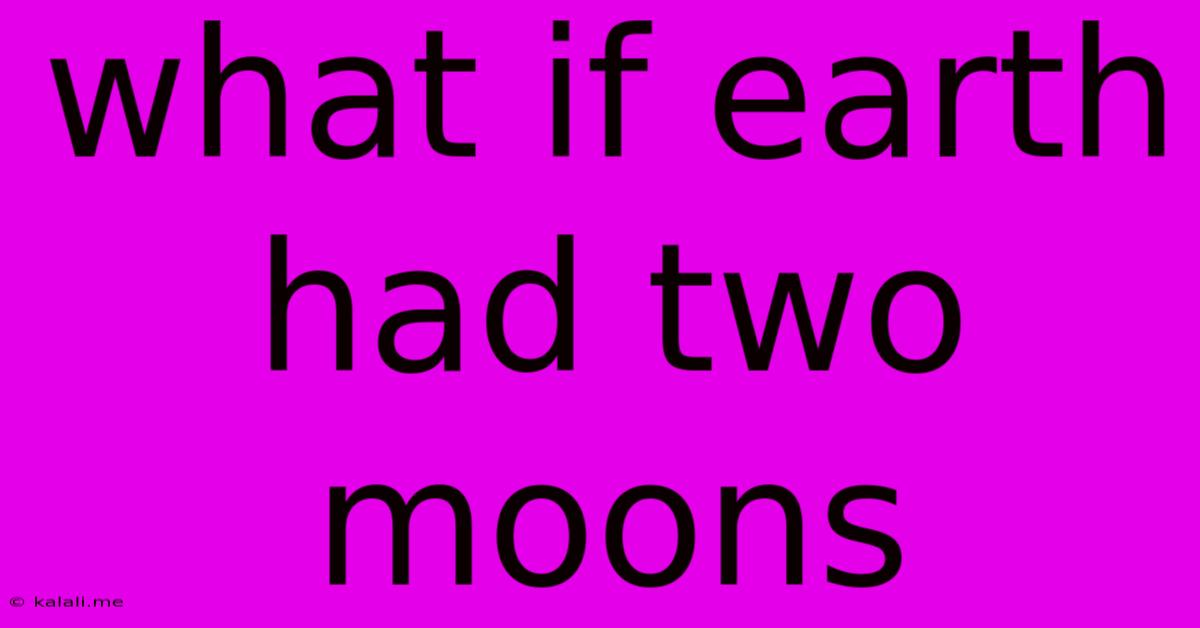What If Earth Had Two Moons
Kalali
Jun 08, 2025 · 3 min read

Table of Contents
What If Earth Had Two Moons? A Look at a Different Night Sky
Imagine a night sky twice as bright, with two celestial bodies vying for attention alongside the stars. What if Earth had two moons? This seemingly simple change would have profound and cascading effects on our planet, impacting everything from tides to the evolution of life itself. This article delves into the fascinating possibilities and potential consequences of a two-moon Earth.
The Gravity Games: Tidal Forces and Orbital Stability
The most immediate impact of a second moon would be on Earth's tides. Currently, our single moon exerts a significant gravitational pull, creating the familiar ebb and flow of ocean waters. A second moon, depending on its size and orbital path, could either amplify these tides dramatically, leading to much higher high tides and lower low tides, or create complex, unpredictable tidal patterns. Coastal regions would experience significantly altered environments, with more frequent and powerful flooding or erosion. The gravitational interaction between the two moons could also influence their orbital stability. They might eventually collide, or one could be flung out of Earth's orbit altogether, resulting in a dramatic celestial event.
A Brighter Night: Illumination and Atmospheric Effects
The presence of two moons would dramatically increase the amount of nighttime illumination. The brightness would depend on the size and reflectivity (albedo) of the second moon. A large, bright moon could make nocturnal activities easier and potentially impact animal behavior, plant growth, and even the evolution of nocturnal species. Additionally, the additional gravitational pull could affect Earth's atmosphere, possibly leading to changes in weather patterns and climate. The interplay of gravitational forces from two moons could also trigger more frequent volcanic activity or seismic events.
Life on a Two-Moon Earth: Evolutionary Implications
The altered tidal patterns, increased nighttime illumination, and potential atmospheric changes would significantly impact the evolution of life on a two-moon Earth. The greater tidal range could have led to the development of different types of marine life, better adapted to more extreme conditions. Nocturnal animals might have evolved differently, with altered visual adaptations or different activity patterns. The impact on plant life could also be significant, affecting their growth cycles and reproductive strategies. It's a fascinating thought experiment to consider how different life forms might have adapted to a world with a double moonlit sky.
Orbital Mechanics and Chaos: The Long-Term Outlook
The long-term stability of a two-moon system is a complex issue, depending on a number of factors including the size, mass, and orbital parameters of each moon. The gravitational interactions between the two moons and the Earth could lead to chaotic behavior over time. Close encounters, collisions, or ejection of one of the moons are all possible scenarios. This makes accurately predicting the long-term evolution of a two-moon system incredibly challenging.
In Conclusion: A Speculative, Yet Enthralling Possibility
The hypothetical scenario of Earth having two moons presents a fascinating opportunity to explore the intricate interplay between celestial mechanics, geology, and biology. While the reality of a two-moon Earth is a matter of speculation, considering this possibility helps us appreciate the delicate balance and interconnectedness of our planetary system and the profound influence of our moon on life as we know it. The changes could be subtle, or they could be catastrophic – a testament to the power of gravity and the unpredictable nature of orbital dynamics.
Latest Posts
Latest Posts
-
Do Above Ground Pools Hurt Property Value
Jun 08, 2025
-
What Time Is It In Japanese Language
Jun 08, 2025
-
How To Finish A Formal Letter
Jun 08, 2025
-
Why Do Fruits Taste Bland When Not In Season
Jun 08, 2025
-
Is A Linear Equation Always A Stright Line
Jun 08, 2025
Related Post
Thank you for visiting our website which covers about What If Earth Had Two Moons . We hope the information provided has been useful to you. Feel free to contact us if you have any questions or need further assistance. See you next time and don't miss to bookmark.